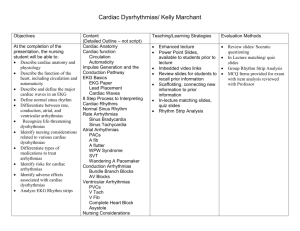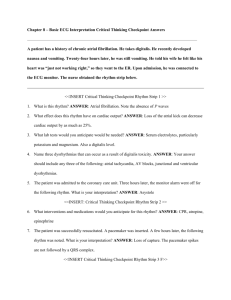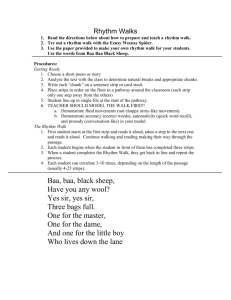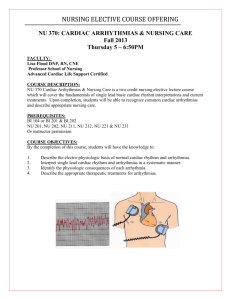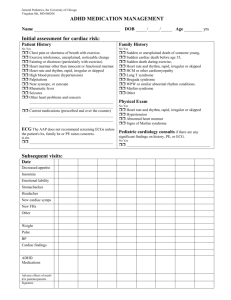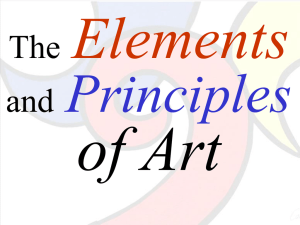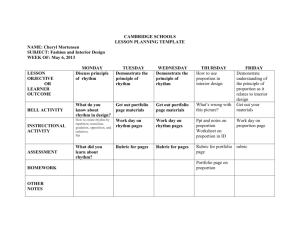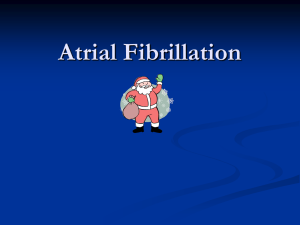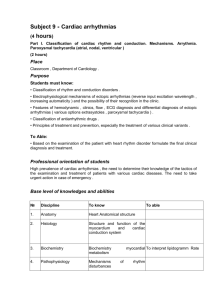Premature Atrial Contractions (PAC)
advertisement
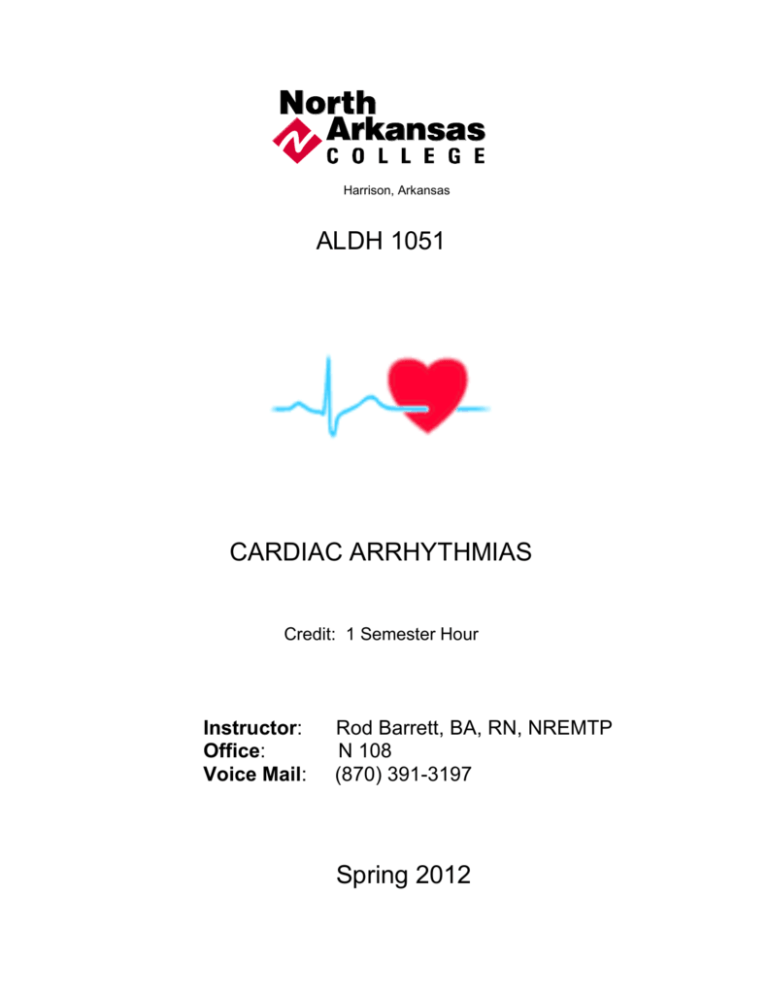
Harrison, Arkansas ALDH 1051 CARDIAC ARRHYTHMIAS Credit: 1 Semester Hour Instructor: Office: Voice Mail: Rod Barrett, BA, RN, NREMTP N 108 (870) 391-3197 Spring 2012 North Arkansas College Harrison, Arkansas Course Syllabus ALDH 1051: Cardiac Arrhythmias Credit Hours: 1 Lecture Hours: 1 Allotment: 16 weeks Course prerequisites: none Instructor: Office: Phone: E-mail: Office Hours: Section: Semester: Day: Time: 66 Spring 2012 Thursday 4:00 – 4:50 p.m. Rod Barrett, B.A., R.N., NREMTP M-108, North Campus (870) 391-3197 rbarrett@northark.edu Tuesday 5:00 p.m. to 6:00 p.m. Thursday 11:00 a.m. to 12:50 p.m. By appointment Required Text: Atwood, S., Stanton, C., & Storey-Davenport, J. (2011). Introduction to Basic Cardiac Dysrhythmias –Revised Reprint. (4th Ed.), St. Louis: Mosby/Jems. ISBN: 978-0323-08532-8. Supplemental Text: Lippincott, (2010). ECG Interpretation Made Incredibly Easy (5th Ed.), Philadelphia, PA: Lippincott, Williams & Wilkins. ISBN: 9781608312894 Purpose: The purpose of the course is to assure that accurate interpretation of cardiac rhythms will be made, that life-threatening situations will be recognized, and that appropriate interventions will be initiated according to approved American Heart Association standards and hospital protocols. Course Description: This is a sixteen-hour introductory course in the interpretation of cardiac arrhythmias designed for health care professionals. Course Objectives: Upon successful completion of this course, the student will be able to: 1. Describe normal cardiac function. (Measured by completion of chapter one review and participation in class discussion.) 2. Determine the following information from an ECG strip: rate, presence or absence of P waves, PR interval, QRS interval, presence or absence of dysrhythmia, origin of dysrhythmia. (Measured by completion of rhythm review strips at end of chapters two and three and participation in class discussion.) 1 Course Objectives: (continued) 3. Define the different types of dysrhythmias including cause and characteristic ECG forms, and management. (Measured by completion of rhythm review strips at end of chapters, correct identification of rhythm flashcards and participation in class discussion.) 4. Define the different types of heart blocks including cause, characteristic ECG wave forms, and management. (Measured by completion of rhythm review strips at end of chapter five and participation in class discussion.) 5. Define the different types of pacemakers and characteristic EGC wave forms. (Measured by completion of rhythm review strips at end of chapter seven and participation in class discussion.) 6. Describe the mechanism of action, therapeutic effects, and adverse effects of various antidysrhythmic drugs. (Measured by participation in group activity and class discussion.) Grading: The course grade is determined as follows: Unit Tests – 75% Final Exam – 25% Grading Scale: 90-100 % A 85-89 % B 75-84 % C 70-74 % D 69 & below F Course Requirements: The student is expected to take exams on the scheduled test dates. Make-up exams will be given only if advance notice of absence is approved and make-up test is taken within one (1) week of the original test date. Failure to take make-up exam within one (1) week will result in a grade of “F” on exam. Students are allowed to take only one (1) make-up test per course. All assignments must be completed and turned in on time in order to receive any credit. All assignments not turned in on time will result in a grade of “F” on assignment. Attendance: Students are expected to attend all class meetings. After a student has missed three scheduled class meetings, the instructor has the prerogative to drop the student with a grade of “W”. Excessive absences prevent the student’s successful completion of the course. No cell phones – turn them off. No text messaging. No food/drink in classroom. May use simple calculators. Major Content: Sinus and atrial dysrhythmias, junctional dysrhythmias, & ventricular dysrhythmias. 2 Major Teaching-Learning Activities: Teacher: Lecture Discussion Audiovisual presentations Learner: Discussion Small group activities Computer assisted instruction Independent study guides Accommodations for Students with Special Needs: The disabilities contact in Student Services is Kim Brecklein. “North Arkansas College complies with Section 504 of the Rehabilitation Act of 1973 and the Americans with Disabilities Act of 1990. Students with disabilities who need special accommodations should make their requests in the following way: (1) talk to the instructor after class or during office hours about their disability or special need related to the classroom work; and/or (2) contact Student Support Services in Room M184 or call 870-391-3338 and ask to speak to Kim Brecklein.” Northark Resources for Students: Northark’s Jenzabar Portal is like a “digital commons”, or a student and staff center on the web. This portal connects students to instructors, counselors, and staff with a single point of access. You will be able to find your classes, connect to BlackBoard, and find groups that you are involved in, like Honors, PBL, Rodeo or other clubs. With one login and password, you have 24/7 access to your campus e-mail, calendars, chat rooms or on-line exams. Without any other login, you can see your Campus Connect services. You can customize your home page as well! SMARTHINKING is a web-based tutoring system that connects students to qualified e-instructors (on-line tutors) anytime, from any internet connection. This service supplements on-campus courses, distance-education courses and the Northark Learning Assistance Center. This service is FREE to currently enrolled students. Find the link to SMARTHINKING on the Northark Web page, student tab. When you click on this link, instructions for starting your own account are provided. This is a service purchased by the Title III grant. Atomic Learning provides web-based software training for more than 100 applications students and educators use every day. The web-site has short, easy-to-understand tutorial movies and resources that can be used like a help-desk for computer questions. This is a FREE service to students and staff (it even answers questions about i-Pods!). Go to http://highed.atomiclearning.com. Northark students should type in: Username: northark Login: pioneers Learn about your personal preference for taking in new information, and how you can study differently to get the most out of your education. Students who take this assessment find out how they prefer to learn, how teachers may prefer to teach, and how to meet in the middle! Students can maximize their time and success in school by following some time-tested strategies for “Studying Without Tears (SWOT)”. 3 COURSE SCHEDULE Week 1 Introduction Chapter 1-Cardiac Anatomy & Physiology Chapter 2-ECG Basics Week 2 Chapter 2-ECG Analysis Chapter 3-Normal Sinus Rhythm Assignment: Rhythm Strip Review pp. 49-52 Week 3 Chapter 3-Sinus Arrhythmias Week 4 Chapter 3-Atrial Arrhythmias Assignment: Rhythm Strip Review pp. 78-83 Week 5 Test #1- Chapter 1, 2, & 3. Week 6 Chapter 4-Junctional Arrhythmias Assignment: Rhythm Strip Review pp. 101-103 Week 7 Chapter 6-Ventricular Arrhythmias Week 8 Chapter 6-Ventricular Arrhythmias Assignment: Rhythm Strip Review pp. 148-153 Week 9 Test #2- Chapters 4 & 6. Week 10 Chapter 5-Blocks Assignment: Rhythm Strip Review pp. 122-126 Week 11 Spring Break – No classes! Week 12 Chapter 5-Blocks Chapter 7-Pacemakers Assignment: Rhythm Strip Review pp. 176-180 Week 13 Test # 3- Chapters 5 & 7 Take-Home Test # 4 Week 14 Chapter 9- Medications for Dysrhythmias Week 15 Nurse Educator Conference Week 16 Chapter 8- Dysrhythmia Review Week 17 Final Exam 4
